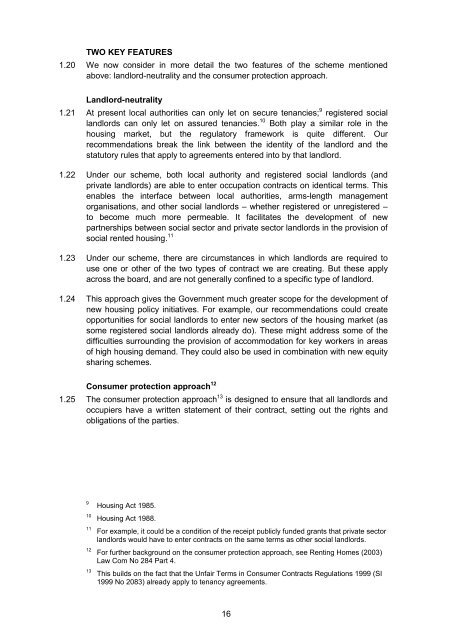Renting Homes: The Final Report - Law Commission
Renting Homes: The Final Report - Law Commission
Renting Homes: The Final Report - Law Commission
You also want an ePaper? Increase the reach of your titles
YUMPU automatically turns print PDFs into web optimized ePapers that Google loves.
TWO KEY FEATURES<br />
1.20 We now consider in more detail the two features of the scheme mentioned<br />
above: landlord-neutrality and the consumer protection approach.<br />
Landlord-neutrality<br />
1.21 At present local authorities can only let on secure tenancies; 9 registered social<br />
landlords can only let on assured tenancies. 10 Both play a similar role in the<br />
housing market, but the regulatory framework is quite different. Our<br />
recommendations break the link between the identity of the landlord and the<br />
statutory rules that apply to agreements entered into by that landlord.<br />
1.22 Under our scheme, both local authority and registered social landlords (and<br />
private landlords) are able to enter occupation contracts on identical terms. This<br />
enables the interface between local authorities, arms-length management<br />
organisations, and other social landlords – whether registered or unregistered –<br />
to become much more permeable. It facilitates the development of new<br />
partnerships between social sector and private sector landlords in the provision of<br />
social rented housing. 11<br />
1.23 Under our scheme, there are circumstances in which landlords are required to<br />
use one or other of the two types of contract we are creating. But these apply<br />
across the board, and are not generally confined to a specific type of landlord.<br />
1.24 This approach gives the Government much greater scope for the development of<br />
new housing policy initiatives. For example, our recommendations could create<br />
opportunities for social landlords to enter new sectors of the housing market (as<br />
some registered social landlords already do). <strong>The</strong>se might address some of the<br />
difficulties surrounding the provision of accommodation for key workers in areas<br />
of high housing demand. <strong>The</strong>y could also be used in combination with new equity<br />
sharing schemes.<br />
Consumer protection approach 12<br />
1.25 <strong>The</strong> consumer protection approach 13 is designed to ensure that all landlords and<br />
occupiers have a written statement of their contract, setting out the rights and<br />
obligations of the parties.<br />
9 Housing Act 1985.<br />
10 Housing Act 1988.<br />
11 For example, it could be a condition of the receipt publicly funded grants that private sector<br />
landlords would have to enter contracts on the same terms as other social landlords.<br />
12<br />
For further background on the consumer protection approach, see <strong>Renting</strong> <strong>Homes</strong> (2003)<br />
<strong>Law</strong> Com No 284 Part 4.<br />
13 This builds on the fact that the Unfair Terms in Consumer Contracts Regulations 1999 (SI<br />
1999 No 2083) already apply to tenancy agreements.<br />
16

















